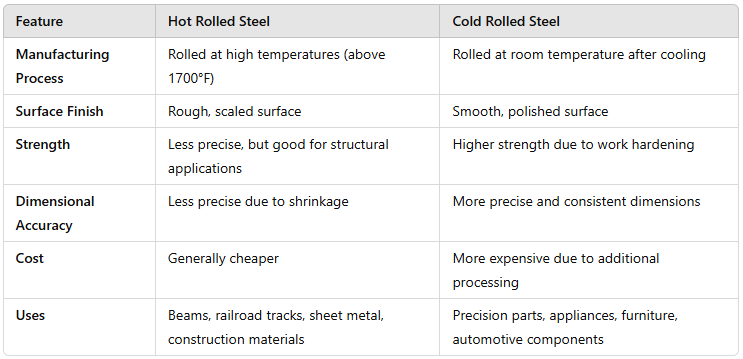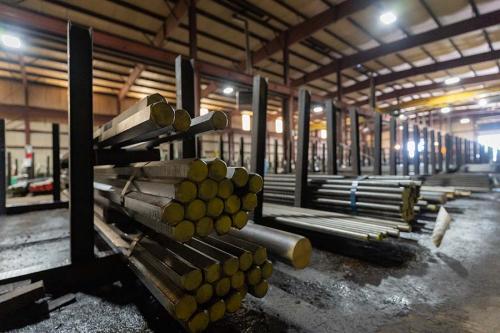To understand the difference between hot and cold rolled steel, one must first understand the fundamental difference between hot rolled vs cold rolled steel. What distinguishes these two types of steel is the process by which each is made. These differences originate at the mills where the steel is produced and often refer to the heat treatment associated with production.

Hot Rolled Steel Bar
Hot rolling, as its name entails, refers to a process in which the steel is heated to temperatures above or around 1700⁰ F. This causes the steel to surpass the recrystallization temperature. The steel can be more easily shaped and formed in this state. Hot rolled steel is generally cheaper than cold rolled steel due to the level of difficulty and duration of the production process. Since the hot rolled steel is only heated once during this process, the manufacturers have less control over the size and shape of the finished products when compared to products that have been cold rolled or finished.
Key Features of Hot Rolled Steel:
-
Manufacturing Process: The steel is heated, rolled, and then cooled, which can lead to slight variations in shape and size due to shrinkage.
-
Surface Finish: It has a rough, scaly surface due to oxidation from high temperatures.
-
Strength & Durability: Less precise in dimension but strong, making it ideal for structural applications.
-
Cost: Generally cheaper than cold rolled steel because it requires fewer processing steps.
-
Applications: Used in construction, bridges, railroad tracks, I-beams, sheet metal, and automotive frames.
Due to the differences in the production processes, hot rolled steel is often cheaper than cold finished steel. As stated above, manufacturers have less control over the quality and specifications of hot rolled vs cold rolled steel. Therefore, hot rolled steel bars are used when precise shapes and tolerances are not required. Some applications of hot rolled steel bars could include making I-beams, general fabrication projects, structural supports, walkways, ramps, and trailers.
Cold Rolled Steel Bar
Cold rolled steel has similarities in the start of its production process that align with the hot rolled steel production process. The most significant difference is that cold rolled steel is essentially hot rolled steel that has been further processed. Cold reduction mills cool the material to ambient temperatures, followed by annealing and/or tempers rolling. Controlling temperatures throughout the cold rolling process will allow for steel production with precise dimensional tolerances and a wide range of surface finishes.
Key Features of Cold Rolled Steel:
-
Manufacturing Process: Hot rolled steel is further processed by rolling it at room temperature, which increases its strength through work hardening.
-
Surface Finish: It has a smooth, polished, and often oily surface, making it ideal for applications requiring a clean appearance.
-
Strength & Durability: Stronger and harder than hot rolled steel due to strain hardening during the rolling process.
-
Dimensional Accuracy: More precise and uniform in thickness, width, and length.
-
Cost: More expensive than hot rolled steel because of additional processing.
-
Applications: Used in automotive parts, appliances, furniture, metal containers, and precision components where a smooth finish and high strength are important.
Cold finished bars and their production process result in higher yield points and have four main advantages. Cold drawing increases yield and tensile strength, eliminating further expensive thermal treatments; turning removes surface imperfections; grinding narrows the original size tolerance range; and polishing improves surface finishes. These qualities make cold products superior in surface finish, tolerance, concentricity, and straightness when compared to hot rolled. The length of production and quality of finished products make cold finished bars being more expensive than hot rolled bars. Real-world applications of cold rolled steel bars may include the production of gears and shafts, oil and water well shafting, industrial buildings, and products that demand defect-free surface finishes.

